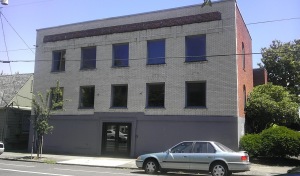 At their December 18th meeting, the Portland City Council voted to deny a controversial application to demolish the Buck-Prager Building, a 1918 contributing building in the Alphabet National Historic District. The proposal sought to replace the existing three-story unreinforced masonry building with a half-block six-story apartment complex, the design of which had yet to be approved. The application represented only the second time in a decade that an owner of a National Register property has proposed demolishing a historic building.
At their December 18th meeting, the Portland City Council voted to deny a controversial application to demolish the Buck-Prager Building, a 1918 contributing building in the Alphabet National Historic District. The proposal sought to replace the existing three-story unreinforced masonry building with a half-block six-story apartment complex, the design of which had yet to be approved. The application represented only the second time in a decade that an owner of a National Register property has proposed demolishing a historic building.
Defined as a Type IV land use application in City’s zoning code, proposals to demolish a National Register building must demonstrate that the replacement project better meets the goals of the city’s Comprehensive Plan and/or justify that the existing building cannot earn a reasonable economic return. In the case of the Buck-Prager Building, the applicant did not argue economic hardship, instead focusing their rationale on Comprehensive Plan goals and an assertion that the building had limited historic significance. Council found that the proposed development would not better meet the City’s Comprehensive Plan goals. Furthermore, Commissioners gave no indication that a revised design would sufficiently address the impacts of demolition.

the building has been altered, it is undeniably a contributing
resource within the Historic District (Photo Courtesy Donald
Genasci).
Even had the demolition application been approved by Council, the design of the new building would have required approval from the Portland Historic Landmarks Commission. In recent cases, the Landmarks Commission have favored designs that embody a high-level of compatibility with the surrounding historic context. Much of the neighborhood testimony focused on the scale of the proposed replacement building and its shortcomings in meeting the district’s design guidelines. Bureau of Development Services staff, the Portland Historic Landmarks Commission, Restore Oregon, and dozens of others weighed in in opposition of the proposal.
While the Buck-Prager Building will not be coming down at this time, there exists no requirement that the building be rehabilitated or reused. That said, the two lots that flank the historic building can be developed so long as the Historic Landmarks Commission approves the proposed design.
The decision may be appealed to the Land Use Board of Appeals.

